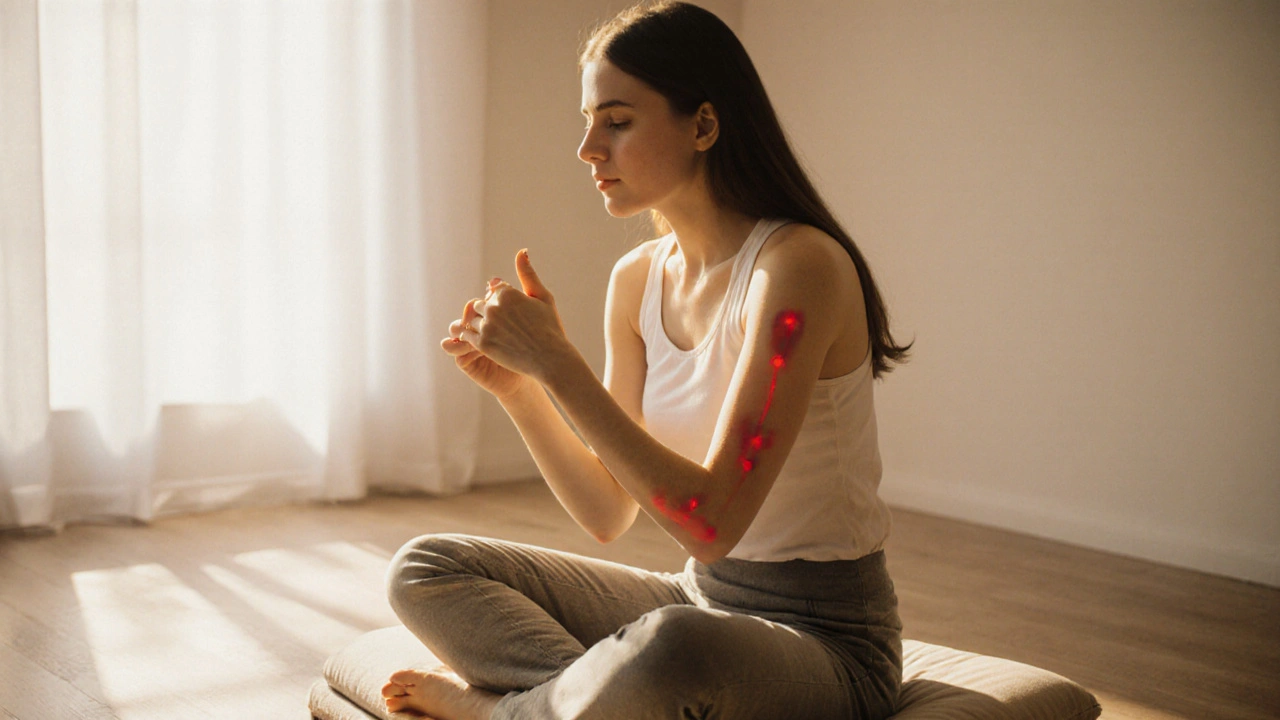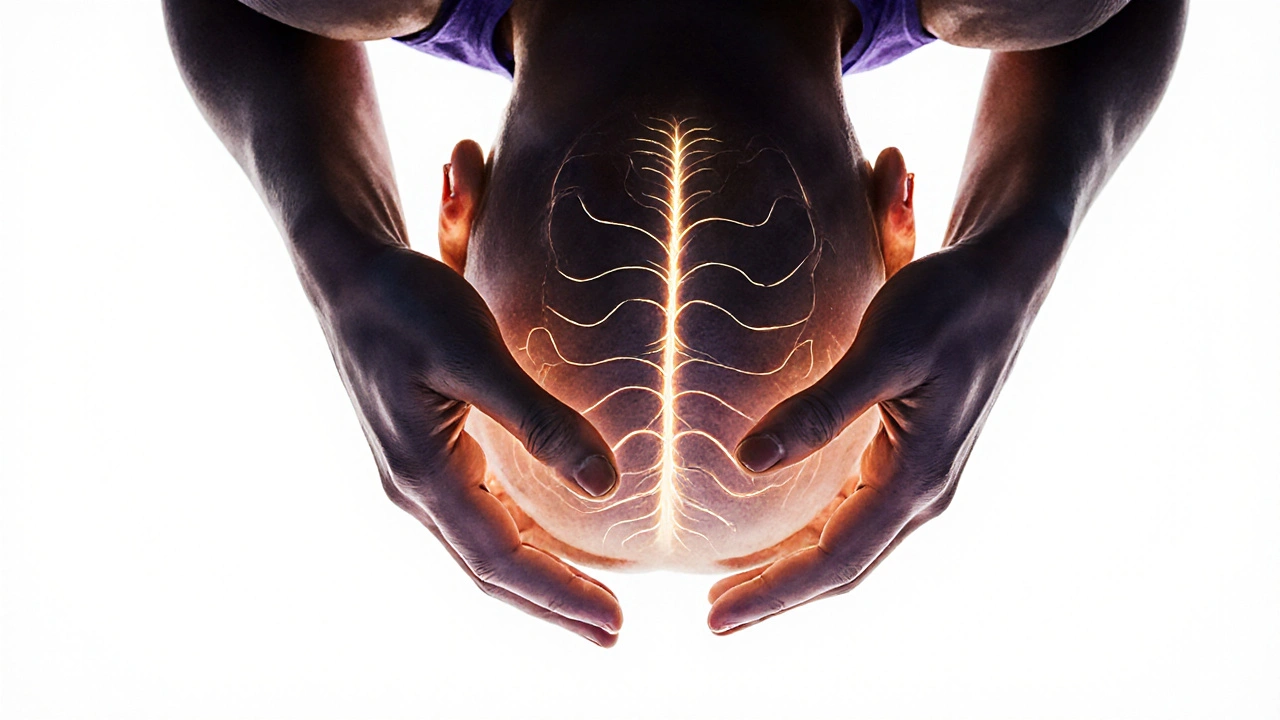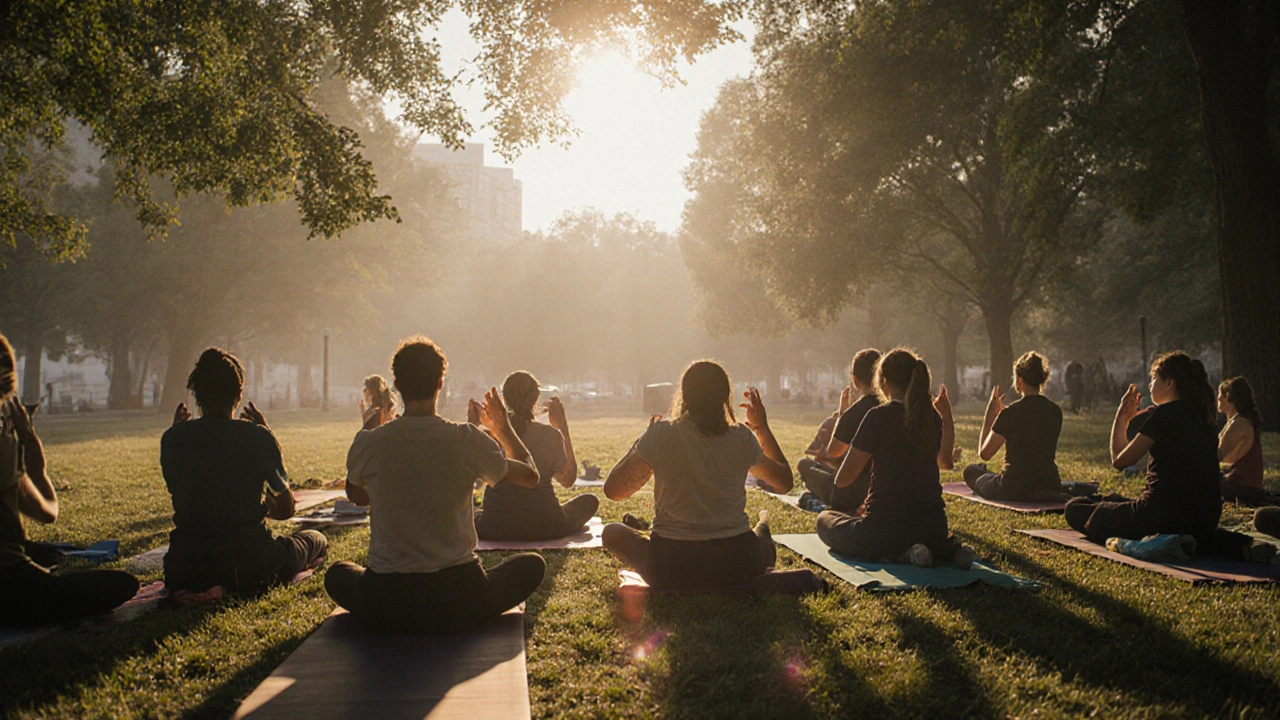Acu-Yoga for Stress Relief: A Step-by-Step Guide
 Nov, 18 2025
Nov, 18 2025
Acu-Yoga Timer & Point Guide
5-Minute Acu-Yoga Routine
Follow this guided acu-yoga practice to calm your nervous system in just 5 minutes. Press the points as instructed while breathing deeply.
Breathe in for 4 counts, hold for 2, breathe out for 6
Heart 7 (HT7)
On your inner wrist, about 3 finger-widths below the crease. Press gently with your thumb. This point calms racing thoughts and eases emotional overwhelm.
Duration: 90 seconds
Pericardium 6 (PC6)
On your forearm, 2 inches above the wrist crease between the same two tendons. Press firmly but comfortably. Reduces nausea, panic, and heart palpitations.
Duration: 90 seconds
GV20 (Hundred Convergences)
At the base of your skull, just below the bump at the back of your head. Press gently with your thumbs while in forward fold. Major calming hub.
Duration: 60 seconds
Hand Pressure
Bring palms together in front of chest. Press firmly and feel the heat build. Activates pericardium and spleen meridians for grounding.
Duration: 30 seconds
Stress doesn’t wait for a convenient time. It shows up when you’re stuck in traffic, staring at a screen past midnight, or just trying to get through the day without losing your cool. If you’ve tried meditation, deep breathing, or even regular yoga but still feel tense in your shoulders or wired in your chest, there’s a quiet, powerful practice you might not have heard of: acu-yoga.
What Is Acu-Yoga?
Acu-yoga isn’t a new fad. It’s a blend of two ancient systems - traditional Chinese medicine’s acupressure points and Hatha yoga’s postures - that work together to calm your nervous system. While yoga stretches your muscles, acu-yoga targets specific pressure points along your body’s energy channels, called meridians. When you hold a yoga pose while applying gentle pressure to these spots, you signal your brain to switch from fight-or-flight mode to rest-and-digest mode.
Unlike regular yoga, where you might focus on alignment or flow, acu-yoga is about stillness and sensation. You’re not trying to touch your toes. You’re trying to feel the release in your liver meridian, the softening around your third eye, the warmth spreading through your palms. It’s yoga with a map - a map of your body’s natural healing points.
Why It Works for Stress
Chronic stress keeps your sympathetic nervous system turned on. Your heart races. Your jaw clenches. Your breath gets shallow. Acu-yoga interrupts that cycle by stimulating parasympathetic nerves - the ones that tell your body it’s safe to relax.
Studies from the Journal of Evidence-Based Complementary & Alternative Medicine show that acupressure applied to points like HT7 (Heart 7) and PC6 (Pericardium 6) significantly lowers cortisol levels within 15 minutes. Add yoga’s controlled breathing and gentle stretching, and you’ve got a one-two punch for anxiety.
People who practice acu-yoga regularly report falling asleep faster, feeling less reactive to triggers, and noticing fewer tension headaches. One 2023 survey of 312 adults in Brisbane found that 78% of those who practiced acu-yoga for just 10 minutes a day for four weeks said their stress levels dropped noticeably - without medication or therapy.
How to Start: The 5-Minute Acu-Yoga Routine
You don’t need a mat, a studio, or even silence. All you need is five minutes and a quiet corner. Here’s how to begin.
- Find your seat. Sit cross-legged on the floor or on a cushion. If your hips are tight, sit on a folded blanket. Keep your spine tall but not stiff. Rest your hands on your knees.
- Press the Heart 7 point. On your inner wrist, about three finger-widths below the crease, you’ll find a small dip between two tendons. That’s HT7. Press it gently with your thumb. Breathe in for four counts, hold for two, breathe out for six. Do this for 90 seconds. This point calms racing thoughts and eases emotional overwhelm.
- Move to Pericardium 6. Now, slide your thumb up your forearm about two inches from the wrist crease, between the same two tendons. That’s PC6. Press firmly but comfortably. Hold for 90 seconds. This point is known to reduce nausea, panic, and heart palpitations - common signs of anxiety.
- Forward fold with scalp pressure. Slowly hinge forward from your hips. Let your head hang. Use your thumbs to press into the base of your skull, just below the bump at the back of your head. This is GV20, the “Hundred Convergences” point. It’s a major calming hub. Breathe into the pressure. Stay here for 60 seconds.
- Hand pressure for grounding. Bring your hands together in front of your chest. Press your palms firmly together. Feel the heat build. Hold for 30 seconds. This activates the pericardium and spleen meridians, helping you feel rooted and centered.
That’s it. Five minutes. No chanting. No complicated poses. Just pressure, breath, and presence.

When to Practice
Acu-yoga works best when it’s part of your rhythm, not a chore. Try it:
- First thing in the morning - before checking your phone
- Right after work - before stepping into the house
- During a lunch break - in your car or a quiet hallway
- Before bed - lying in bed, no lights on
One woman in Toowoomba, who works night shifts, does this routine during her 3 a.m. coffee break. She says it’s the only thing that lets her reset without reaching for sugar or caffeine. You don’t need perfect conditions. You just need consistency.
What to Avoid
Acu-yoga is gentle, but it’s not for everyone the same way.
- Don’t press hard enough to cause pain. You should feel a dull ache, not sharp pain. If it hurts, ease off.
- Avoid acu-yoga if you’re pregnant without consulting a professional. Some points, like SP6, can stimulate contractions.
- Don’t do it right after a heavy meal. Wait at least 90 minutes.
- If you have open wounds, infections, or recent surgery near any pressure point, skip that spot.
Also, don’t expect instant miracles. Like brushing your teeth, the benefit builds over time. One session helps. Ten sessions rewire your stress response.
What Comes Next
Once you’re comfortable with the five-minute routine, you can expand. Add more points:
- LV3 (Liver 3) - between your big and second toe. Helps with anger, frustration, and tight shoulders.
- GB20 (Gallbladder 20) - at the base of your skull, just behind your ears. Releases neck tension and mental fog.
- Yintang - between your eyebrows. The “third eye.” Calms racing thoughts and improves focus.
You can also try acu-yoga sequences designed for specific issues: insomnia, work burnout, or digestive stress. Many people in Brisbane start with the basic routine and later join local acu-yoga circles - small groups that meet in parks or community centers for guided sessions.

Tools That Help
You don’t need gadgets, but a few things make it easier:
- A small acupressure ring or massage ball - for hard-to-reach spots like the soles of your feet.
- A yoga block - to support your hips or back in seated poses.
- A timer app - set for 90-second intervals so you don’t have to watch the clock.
Some people use a simple wooden acupressure mat for 10 minutes after their routine. It’s not required, but it amplifies the effect by stimulating dozens of points at once.
Real Results, Real People
A teacher in South Brisbane started acu-yoga after her doctor told her she had chronic stress-induced gastritis. She did the routine every morning for six weeks. Her stomach pain disappeared. Her sleep improved. She stopped taking antacids.
A construction worker in Logan did it during his lunch break. He said he used to snap at his kids. Now, he takes three deep breaths before answering them. He doesn’t call it therapy. He calls it his reset button.
You don’t need to fix everything. You just need to find one moment each day where you’re not chasing, not fixing, not performing - just feeling your body breathe.
Can acu-yoga replace therapy or medication for anxiety?
No. Acu-yoga is a supportive practice, not a medical treatment. It can reduce symptoms of stress and anxiety, but it doesn’t replace therapy, counseling, or prescribed medication. If you’re dealing with clinical anxiety or depression, work with a licensed professional. Acu-yoga can be a powerful complement - not a substitute.
How long until I feel the effects?
Some people feel calmer after one session - especially if they’re holding a point like PC6 during a panic moment. For lasting changes, aim for daily practice over four to six weeks. That’s how long it typically takes for your nervous system to rewire its stress response.
Do I need to be flexible to do acu-yoga?
No. Flexibility has nothing to do with it. Acu-yoga is about pressure and breath, not how deep you can stretch. You can do it sitting, lying down, or even standing. If you can’t sit cross-legged, sit in a chair. The points still work.
Can I do acu-yoga with my kids?
Yes. Kids respond well to gentle pressure. Try the hand pressure technique (palms together) or pressing the space between their eyebrows. It’s a great way to help them calm down before bed or after school. Keep sessions short - 2 to 3 minutes is plenty for young children.
Is acu-yoga the same as reflexology?
No. Reflexology focuses only on the feet and hands, based on maps of the body on those areas. Acu-yoga uses the full body’s meridian system - including arms, head, back, and legs - and combines it with yoga postures. It’s broader, deeper, and more integrated.
Final Thought
You don’t need more time. You need better moments. Acu-yoga turns five minutes of stillness into a reset for your entire nervous system. It’s not about doing more. It’s about feeling more - the warmth in your palms, the softening in your jaw, the quiet after the breath. That’s where real relief begins.
